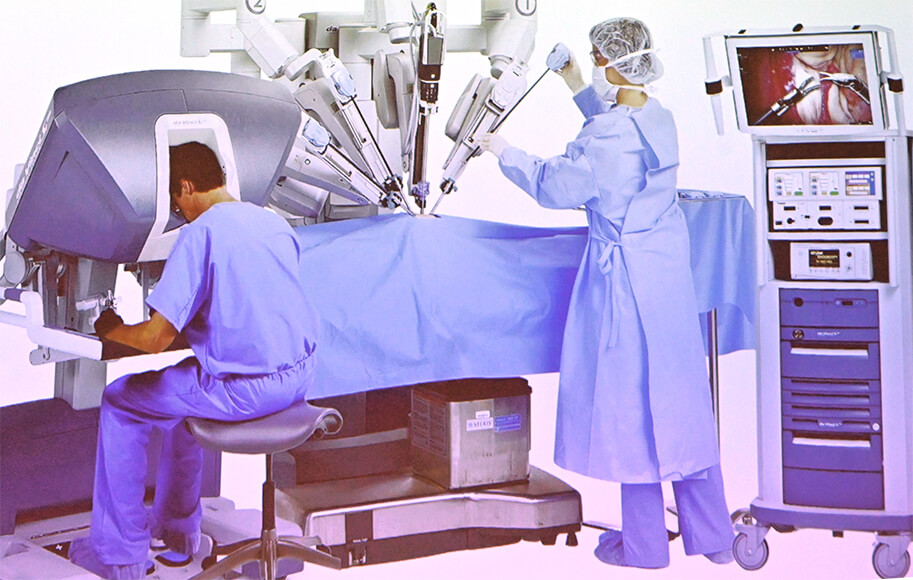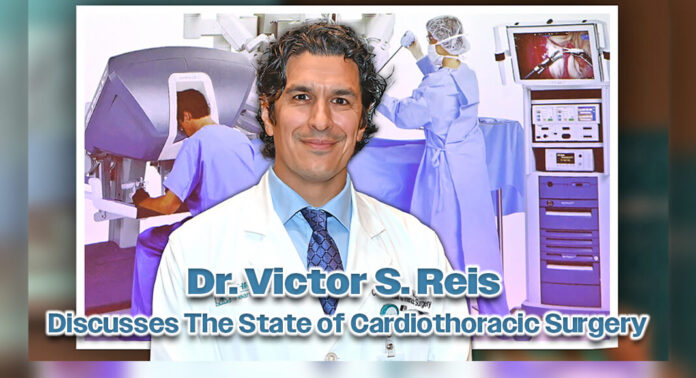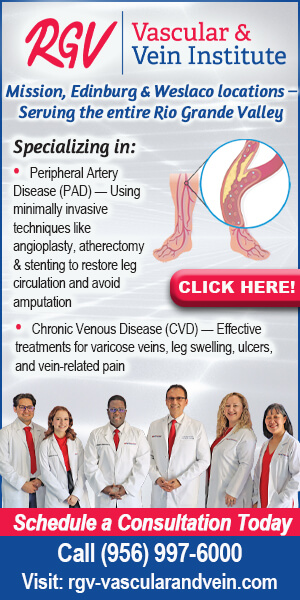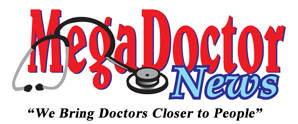Mega Doctor News
By Roberto Hugo González
McAllen, TX – March 2025 – DHR Health hosted its 15th Annual Community Health Fair on February 22, 2025. The free event, open to families, children, and individuals, offered complimentary health screenings and wellness sessions led by top physicians. One of the day’s highlights was a compelling presentation by Dr. Victor S. Reis, MD, a renowned cardiovascular and thoracic surgeon at DHR Health, who delivered an in-depth discussion on cardiothoracic surgery’s current state and future. “I’m thrilled to be here in my home community to share what we are doing in the heart and lung surgery field,” Dr. Reis declared.
Dr. Reis opened his address by explaining the fundamentals of his specialty. “Cardiothoracic surgery is all about repairing or replacing the organs inside your chest – mainly the heart and lungs,” he said. He described the field as highly specialized and critically important in treating life-threatening conditions. “This is not just any type of surgery; it involves operating on the very organs that keep you alive,” he added emphatically.
He described the rigorous training required to become a cardiothoracic surgeon. “It takes about four years of college, four years of medical school, five years of general surgery training, and then an additional two years of specialized training in heart and lung surgery.” Dr. Reis proudly recounted his educational journey, “I completed my undergraduate studies at UTSA, attended Texas Tech Medical School, did my general surgery training in Pennsylvania, and further honed my skills in Miami.”
During his talk, Dr. Reis emphasized why heart surgery remains indispensable. “The heart is a pump – it must continuously deliver oxygen-rich blood to every part of your body,” he explained. “But over time, arteries can get clogged with cholesterol and calcium, much like a pipe blocked by rust.” He vividly described the process, “When these blockages occur, the heart has to work much harder. If the blockage is severe, it can lead to a heart attack, where part of the heart muscle dies.”
Dr. Reis elaborated on the treatment options available. “There are two main ways to address these blockages; we can use a stent to open up the artery, or we can perform a bypass surgery to create a new path for the blood.” He explained that while stents are less invasive and offer quicker recovery times, bypass surgery is often more effective for patients with complex conditions. “In cases where multiple arteries are blocked, or in patients with conditions like diabetes or kidney disease, bypass surgery is the superior choice,” he asserted.
Dr. Reis provided clear guidance on when each procedure is preferable. “Stents are a fantastic innovation; they’re small metal tubes inserted into the artery to restore blood flow. The procedure is minimally invasive, and patients often recover in just a day or two,” he noted. However, he stressed that “for patients with multiple blockages or more complex heart disease, bypass surgery remains the gold standard.”
He described the bypass procedure in straightforward terms: “We take a healthy blood vessel from another part of the body, either an artery from the chest or a vein from the leg, and we use it to bypass the blocked artery. This creates a new blood flow route to the heart muscle.” Dr. Reis confidently stated, “Even though bypass surgery is a major operation, the advancements in surgical techniques have made it extremely safe. Today, the risk of death is less than one percent.”
Another critical topic in Dr. Reis’ presentation was aortic stenosis, a condition where the aortic valve narrows and restricts blood flow. “The aortic valve works like a door – it lets blood exit the heart and go to the rest of the body,” Dr. Reis explained. “When this door becomes too tight, it forces the heart to work harder, and that can lead to serious symptoms like shortness of breath, chest pain, or even fainting.”
Traditionally, fixing a narrowed valve required open-heart surgery. “In the past, we had to open the chest, stop the heart, and replace the valve. It was a very invasive process,” he recalled. However, he highlighted the revolutionary advancement of Transcatheter Aortic Valve Replacement (TAVR). “With TAVR, we can replace the valve through a catheter inserted in the leg without having to open the chest or stop the heart,” he said. “This procedure has significantly reduced recovery time and the risk of complications.”

Despite the advantages of TAVR, Dr. Reis emphasized that traditional surgery still has its place. “For younger patients, especially those under 65, and those with complex valve issues like infections or severe leaks, open-heart surgery remains the best option,” he noted. “The durability of surgically replaced valves is superior, and in many cases, it’s the only viable solution.”
Shifting his focus to lung surgery, Dr. Reis discussed how technology has transformed lung operations. “Not long ago, lung surgery meant a large incision, spreading the ribs, and a long, painful recovery,” he remarked. “Today, we use robotic-assisted surgery, which is far less invasive.”
Dr. Reis described the advantages of using the Da Vinci Robot. “The Da Vinci Robot allows us to perform lung surgeries through small incisions. We insert a tiny camera and specialized instruments to operate with remarkable precision.” He explained the benefits clearly, “Patients who undergo robotic surgery experience less pain, have smaller scars, and can return home much faster – often within one or two days.”

He also pointed out that robotic surgery mainly benefits lung cancer patients. “For those with lung cancer, robotic surgery means a shorter hospital stay and a much quicker recovery – sometimes in as little as two weeks compared to three months with traditional surgery,” he said. “It’s a game changer for our patients.”
Looking ahead, Dr. Reis expressed optimism about the future of cardiothoracic surgery. “Medical technology is evolving at an unprecedented pace,” he stated. “We are constantly developing new techniques that are less invasive and more effective. However, I must stress that traditional surgery still has its crucial role.”
He explained, “Stents, TAVR, and robotic-assisted surgeries are all wonderful advancements, but they are not replacements for open-heart surgery in every case. For patients with very complex heart conditions, surgery remains the most reliable method.” Dr. Reis’s balanced view resonated with the audience as he stressed the importance of individualized treatment plans. “Every patient is different, and the best treatment for one person might not be the best for another.”
Dr. Reis also spoke passionately about the community’s role in healthcare. “Events like the DHR Health Community Health Fair are essential,” he said. “They give people access to free screenings and valuable health information that can truly save lives.” He emphasized that early detection of heart and lung diseases is key to successful treatment. “If you catch a problem early, whether it’s heart disease or lung cancer, your chances of a full recovery are much higher,” he explained.
He encouraged community members to take advantage of these free services. “I urge everyone to get screened regularly and to speak with a healthcare professional if you have any concerns,” he advised. “Your health is your most important asset, and early intervention can make all the difference.”
Throughout his address, Dr. Reis maintained an upbeat and reassuring tone. “Advancements in our field have made procedures safer and more effective than ever before,” he said. “I understand that the idea of heart or lung surgery can be frightening, but I want you to know that our techniques have come a long way. Our patients are recovering faster, experiencing less pain, and returning to their normal lives much sooner.”
Dr. Reis also highlighted the efforts of his team at DHR Health. “It’s not just about the surgeon; it’s about the entire team – the nurses, the anesthesiologists, the technicians – all working together to ensure the best outcome for every patient,” he noted. “At DHR Health, we are committed to providing the highest level of care with compassion and expertise.”
Dr. Reis’s presentation bridges the latest technological advances and the human aspect of medicine. “While technology is an incredible tool, it’s the human touch that makes a difference in patient care,” he said. “Every procedure we perform, whether it’s a stent, a bypass, or robotic surgery, is done with the patient’s well-being as our top priority.” He reiterated, “We are constantly learning and adapting, but the goal remains the same – to improve patient outcomes and to give people a better quality of life.”
As the community health fair drew to a close, Dr. Reis left the audience with a clear and inspiring message, “Your heart and lungs are vital to your life. Take care of them, get regular check-ups, and don’t hesitate to seek help if something doesn’t feel right.” His words resonated deeply with the attendees, who left with a greater understanding of cardiothoracic surgery and renewed hope for the future of their health.
Dr. Reis concluded by saying, “I’m proud to be part of a team that is not only advancing the field of surgery but also making a tangible difference in people’s lives. Thank you for joining us today and for taking the first step towards a healthier future.”
See related story:










